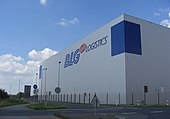Senator-Apelt-Strasse
| Senator-Apelt-Strasse | |
|---|---|
| Street in Bremen | |
| Basic data | |
| city | Bremen |
| district | Woltmershausen , Strom , Seehausen |
| Created | 1964 |
| Cross streets | Senator-Paulmann-Str., Schriefersweg, Warturmer Heerstraße , Hempenweg, Visbeker Str., Gerstenneulandsweg, Carl-Stockhinger-Str., Niedervielander Str., Neustädter Hafentor, Bürgermeister-Noltenius-Str., Stromer Landstrasse , Ahrensstr., Senator-Borttscheller -Straße, Georg-Henschel-Straße, Rudolf-Diesel-Straße, Mühlenhauser Weg, Senator-Blase-Straße, Senator-Mester-Straße, Alter Weideweg, Seehauser Landstraße. |
| use | |
| User groups | Cars, bikes and pedestrians |
| Road design | two lane road |
| Technical specifications | |
| Street length | 6800 meters |
The Senator-Apelt-road is a central access road to Bremen , district Woltmershausen and districts Bremen power , Seehausen near the Neustadt port . It is the second longest street in the Bremen area and leads in predominantly south-north, then east-west and then again in south-north direction from Carl-Francke-Strasse and the 281 federal motorway to Seehauser Landstrasse.
It is divided into the sub-areas
- Carl-Francke-Straße to Niedervielander Straße and
- Niedervielander Strasse to Seehauser Landstrasse.
The cross streets and connecting streets were named u. a. as Carl-Francke -Strasse 1954 after the craftsman and entrepreneur (1843-1931), Autobahn A 281, Senator-Paulmann-Strasse after the school senator Christian Paulmann (SPD, 1897-1970), Schriefersweg (?), Warturmer Heerstrasse after the earlier one small village Ware ( Ware = fish weir), Hempenweg 1888 after a field name , two unnamed paths to the allotment gardens Am Reedeich and Auf den Ruten , Visbeker Straße after the small community, Gerstenneulandsweg after the field barley , Carl-Stockhinger- Straße after the chairman of the SPD fraction (1894–1951), Niedervielander Strasse after the area where Seehausen , Strom , Woltmershausen and the Neustädter Hafen lie as well as a marshland (ndt. Vie = swampy area), unnamed street to the motorway entrance, Neustädter Hafentor after the way in the Hafen, Bürgermeister-Noltenius-Strasse after the mayor (CDU) Jules Eberhard Noltenius (1908–1976), Stromer Landstrasse after the Strom district, Ahrensstrasse after the captain and Kom modore Adolf Ahrens (1879–1957), Senator-Borttscheller-Strasse after the port senator Georg Borttscheller (FDP, 1896–1973), Georg-Henschel -Strasse 2000 after the entrepreneur (1759-1835), Rudolf-Diesel- Strasse 1996 after the Inventor of the diesel engine (1858-1913), Mühlenhauser Weg after the Mühlhauser Fleet and the earlier mills, Senator-Blase-Straße 1997 after the building senator Wilhelm Blase (SPD, 1909-1994), Senator-Mester-Straße after the Senator Hermann Mester ( SPD, 1888–1973), unnamed way, Alter Weideweg, unnamed street, unnamed way and Seehauser Landstraße after the district; otherwise see the link to the streets.
history
Surname
Senator-Apelt-Strasse was named in 1964 after the lawyer, politician ( DVP , BDV / FDP ) and senator in the Senate of the Free Hanseatic City of Bremen Hermann Apelt (1876-1960). After 1945, when the Bremen state was rebuilt, the restoration of the ports was also due to him.
development
The Bremen Freight Transport Center , the largest freight transport center in Germany, developed along the road . The center extends over an area of 472 hectares. It provides around 1.2 million square meters of hall space for currently over 150 companies. The GVZ can be reached via the motorway and freight railroad and is connected to the North Sea and the feeder services via the Neustädter Hafen by the Unterweser federal waterway via Bremerhaven .
traffic
The road was created in the 1960s together with the GVZ and changed when the motorway was built.
In local transport in Bremen, the bus routes 62 (Stromer Straße - Reedich-Nord), 63 (Hauptbahnhof ↔ Güterverkehrszentrum (GVZ)), 65/66 (only a few times) drive through the street.
Buildings and facilities
The street is mostly built on with commercial buildings and halls.
Notable buildings and facilities
- Underpass of the railway tracks to the port
- Senator-Paulmann-Strasse No. 1 and 49: four 3-tiered Houses from around 1970
- Hakenburger See and a canal accompanying the road
- No. 9: 1-sch. car dealer
- 1-sch. Water lifting system
- No. 47: 3-sch. Commercial building
- No.: 5-gesch. Tobacco Quarter building
- Wardamm-Woltmershausen allotments
- Carl-Stockhinger-Strasse No. 3: 2-storey. Technology center
- From the Autobahn and Niedervielander Straße: 472 hectares of Bremen freight traffic center (GVZ) with commercial halls and buildings belonging to various companies in the typical transport sector (freight forwarders), logistics service providers, logistics-intensive industrial and trading companies ( Tchibo and others) and service providers. The larger companies include the BLG Logistics Group and the mail freight center of DPD Deutscher Paket Dienst .
- Bridge over the tracks to the Grolland marshalling yard
- East side from Mühlenhauser Weg: 84.7 hectare green zone and nature reserve from 1971 with a quarry pond as a flood protection polder between Senator-Apelt-Straße and Neustädter Hafen
- Seehauser Landstrasse No. 99: Hansewasser Bremen with the Seehausen sewage treatment plant from 1965 with mechanical clarification and the extensions from 1984 as a biological sewage treatment plant and from 1996 as clarification of nitrogen and phosphorus compounds.
See also
literature
- Herbert Black Forest : The Great Bremen Lexicon. 2nd, expanded and updated edition. In two volumes. Edition Temmen , Bremen 2003, ISBN 3-86108-693-X (first edition: 2002, supplementary volume A – Z). 2008, ISBN 978-3-86108-986-5 .
- Monika Porsch: Bremer Straßenlexikon , complete edition. Schünemann, Bremen 2003, ISBN 3-7961-1850-X .
Individual evidence
Coordinates: 53 ° 5 ′ 20 " N , 8 ° 44 ′ 38.5" E


